All is quiet on the Covid front. Let us hope is stays that way.
Especially since we have no funding for anything.
Executive Summary
- BA.2 on the rise, leading to some local rises in cases as in NY.
- Federal government is out of funding for Covid.
- China looking tenuous but has not lost yet.
Let’s run the numbers.
The Numbers
Predictions
Prediction from last week: 180k cases (-5%) and 6,300 deaths (-10%).
Results: 177k cases (-7%) and 7,045 deaths (-18%).
Prediction for next week: 177k cases (unchanged) and 6,200 deaths (-12%).
I am leaving the prediction as written but what happened was I accidentally multiplied from my prediction from the previous week rather than from the actual numbers. It is interesting that zero people pointed this out to me, but the intent of the prediction was a 10% decline, so either way I missed by something like 10%, except in opposite directions.
The important thing is that the actual result was a pleasant surprise this week rather than a disappointment. Deaths per cases-three-weeks-ago remain highly elevated, but I have settled into that being due to there being a second component of cases-within-last-60-days where such deaths are counted whether or not they have anything to do with having had Covid.
Conditions should remain similar, but BA.2’s share should rise again. Since there is now ~12% more BA.2, this should approximately stabilize the case numbers week over week.
Deaths


Notes on Deaths:
South Carolina reported negative 2,465 deaths, which I changed to +100 deaths.
Florida did not report at all, I approximated 700 deaths.
This thread attempts to explain the high death counts in the context of Denmark, claiming that many of the Covid deaths are ‘with-Covid’ and not causally linked to the disease. The impact is potentially on the order of 40% of deaths being misattributed, which would go a long way to explaining why death rates are not declining so quickly when cases are in rapid decline here in America.
Cases


As a share of cases, BA.2 rose from about 23% to 35%, as noted in the next section it should continue to increase for a bit but seems unlikely to cause a major wave or crisis. Perhaps modest prevention measures will have to be readopted, perhaps not, but private reaction should be sufficient there.
China
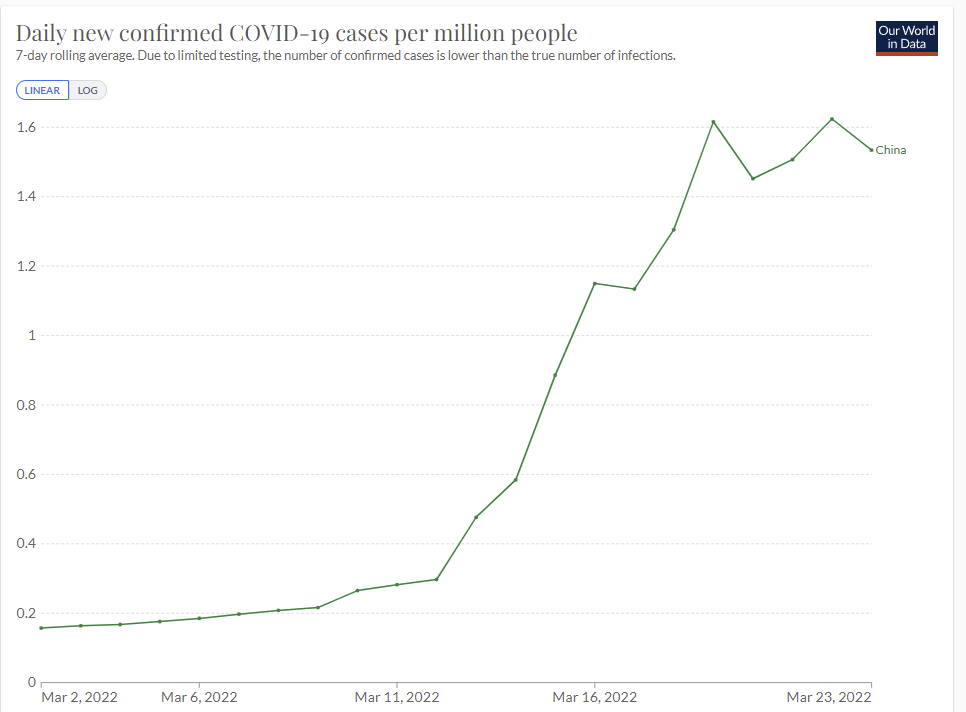
China ‘blames’ BA.2, continues to use half-measures.
Shenzhen is pretty much returning to normal, but many people were still getting tested every day so they could present valid negative results as needed for in-person business meetings, he said. “Let’s hope [with] all these experiences and all the China data, the Chinese government can find a way to go from zero-Covid to ‘live with Covid.’”
Shenyang locked down two days ago, population 9 million. But not Shanghai, despite its cases. Reuters reports.

A leading expert says it is contained. Well, that’s that. Except, how would that be true?
Here’s CNN:
China’s zero-Covid policy is showing signs of strain. But ditching it now could be a disaster
To respond, China has rolled out its well-worn methods for controlling the disease: placing tens of millions of residents under some form of lockdown, shuttering factories in the tech hub of Shenzhen, constructing makeshift hospitals to isolate cases in hard-hit Jilin province and rounding up “close contacts” of cases for surveillance or quarantine.
But this approach, known broadly as “zero-Covid,” is showing signs of strain.
…
“We haven’t prepared anything of what we need to prepare. How could we possibly dare to ‘lie down’ (and allow the virus to spread)?”
…
And even if this outbreak is brought under control, these questions will continue to rise to the fore in China, as containing Omicron amounts to a “Sisyphean effort” for China’s leaders and its people, he said.
“They are not going to eradicate all the Omicron cases in China…they are just waiting for the next round.”
This seems right. China has put its chips on Covid Zero and not used that time to prepare to lose gracefully, because that would cost face. Now that Omicron is both making it all but impossible not to lose and making losing potentially acceptable, they find they have not made the necessary prep work, and losing would perhaps not be so graceful.
Yet there remains all this talk of potential containment, despite talk like this.

The good news for China is that the graph above is not a rocket straight up, and the last four days look roughly stable. Even that is impressive if it is real, which I suspect it at least partially is not. They have done a better job stalling than I expected, but reach an equilibrium with this approach? I remain deeply skeptical.
Physical World Modeling
Moderna vaccine achieves its primary endpoint of similar-to-adult effectiveness in young kids.
Thread on BA.1 vs. BA.2, believes weight of Omicron’s advantage is primarily immune evasion and shorter generation time rather than having a higher baseline R0. Notes that BA.1 and BA.2 give strong cross-protection against each other.

This suggests a relatively small ~16% reproductive advantage over BA.1, while BA.1 continues to decline, implying R0 ~ 1.1 for BA.2 right now. That is of course still enough to create a huge impact on a weekly basis, but seems unlikely to be sufficient for a big surge or wave in the United States any time soon.
It is causing a wave of sorts in Europe, but as Kai says in this thread, it is not translating into health systems problems or lots of deaths. So the decision to open things up is still looking good.
A scary headline finding, if you don’t think about it at all.


The flip side of this is oh look, those who get infected anyway don’t produce that many antibodies and they are still almost all fine. It always all depends on what you are controlling for. If we didn’t know that Omicron was milder despite this, this would be worrisome. As it is, the direction of the update is at best non-obvious.
South Korea has a huge infection rate, but relatively few deaths. Note that while delays can improve outcomes by allowing for more vaccination and better treatments, and as it turns out via Omicron, looks like the final case numbers are going to end up similar.
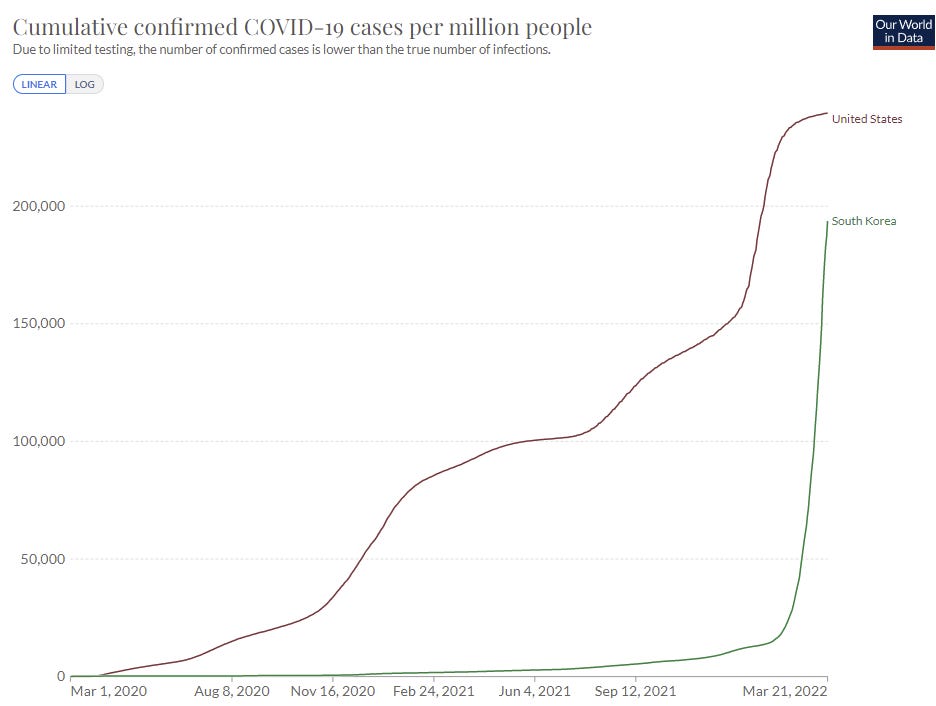
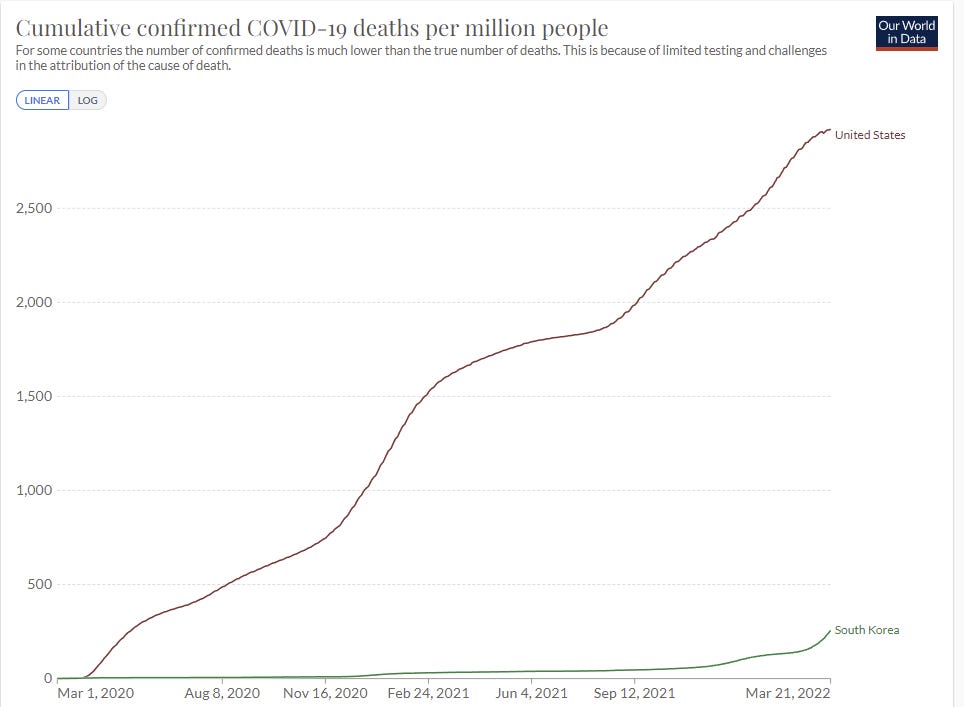
It is interesting the extent to which the USA cumulative death count looks like a straight line.
Most of South Korea’s cases lie within the three-week window – on this graph, about 2/3rds are less than three weeks old, so it is too soon to fully render a verdict here in terms of how much better the outcomes will be, but the fact that South Korea is not facing an overwhelming disaster at these case rates is victory enough.
Hong Kong’s death rate looks like it is going to be far worse (MR). There is very good reason to be worried about what happens when areas that have not previously had Covid are hard hit.
Report that young children were five times as likely to be hospitalized by Omicron as they were by Delta, conditional on a known infection. What was that?
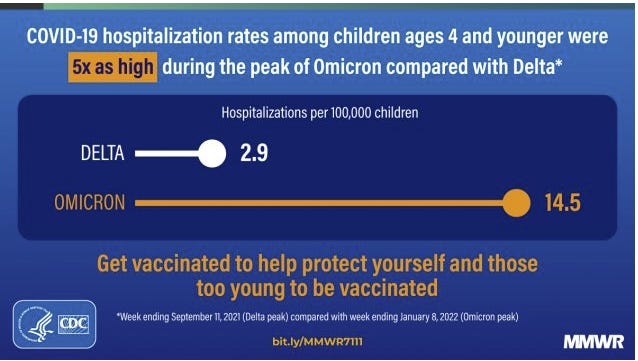
This is not per case. This is per population, for the weeks with the most cases for Delta and Omicron respectively. So mostly this is the fact that there were a ton of Omicron cases that week, being spun as if this result meant anything else or was remotely surprising.
Italian study claims that ventilation can cut cases in school by 82%. That seems too high to me, but it is still the lowest hanging fruit we have.
Federal Funding
We have still not yet received the Federal Funding. We cannot take our collages out to dinner, pay our brothers to come and sing, or (checks notes) buy vaccines for later in the year. Or, as far as I can tell, pay for the Covid-19 treatments for the uninsured.
Or for work to prevent other pandemics in the future, in addition to what is necessary to deal with the current one. Congress is unwilling to fund pretty much anything.
The verdict is in. The Covid-19 pandemic was insufficient to cause the United States to take pandemics seriously. We spent trillions, much of it on unnecessary and counterproductive overstimulation of the economy that is now causing lots of inflation. We don’t have billions to stop this from happening again, or even to provide for basic needs.
In an adversarial political system, such failures seem increasingly inevitable. One side spends all that it is given intending to come back for more, intentionally starving vital things of secured funds so that they can have a better case for more funding. The other side looks at that and says they’re not falling for such tactics, they’d rather not fund the vital things. And so it goes.
Prevention and Prevention Prevention Prevention

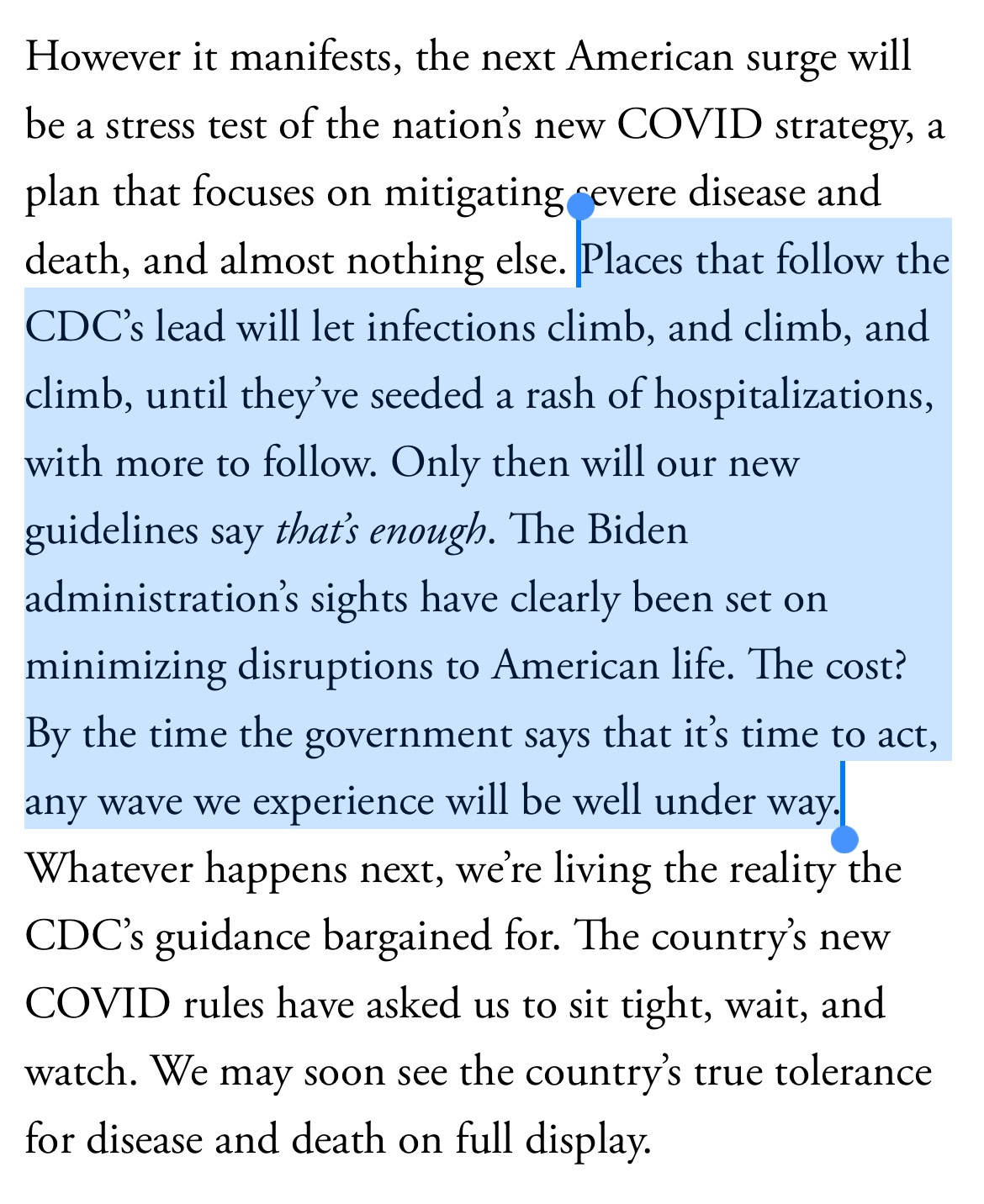
The alternate plan would be to impose extreme measures before there is ‘a rash of hospitalizations’? In other words, before there is a practical impact on people’s lives, and before you know if there even will be much of one? Before cases have grown common enough that the wave will cause itself to end rather than force us into Permanent Midnight trying to keep it at bay, except that will fail because when no one is getting sick no one is going to much care?
So, yes. Absolutely, this is the correct strategy. Good to have it explicit.
And to have the other position explicit.
In a sense, whether a bad BA.2 surge is nigh “doesn’t really matter,” he told me, “in terms of thinking about the things we should be doing now.”
In other words, a call to universally do all the things, forever, no matter what.
Airlines call for lifting of mask mandate.
A central question going forward continues to be whether ‘you might save a life’ is sufficient justification for ongoing prevention efforts. In which case, the question is ‘why is this cause different from all other causes?’
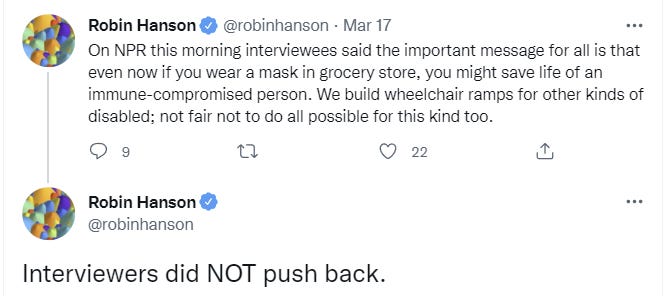

If such standards are used to determine behavior, civilization is impossible. As would be life itself.
Liberals continue to be very worried about Covid.
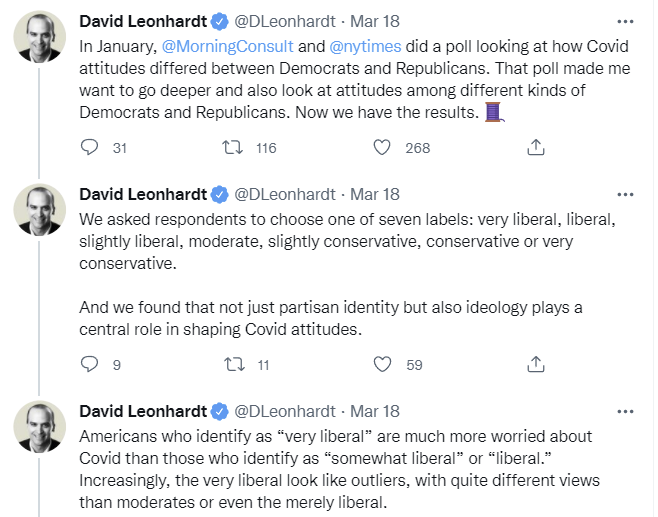


No need to mince words here. That 50% is mostly wrong.
What’s more interesting is, notice that this next chart is almost the same chart.

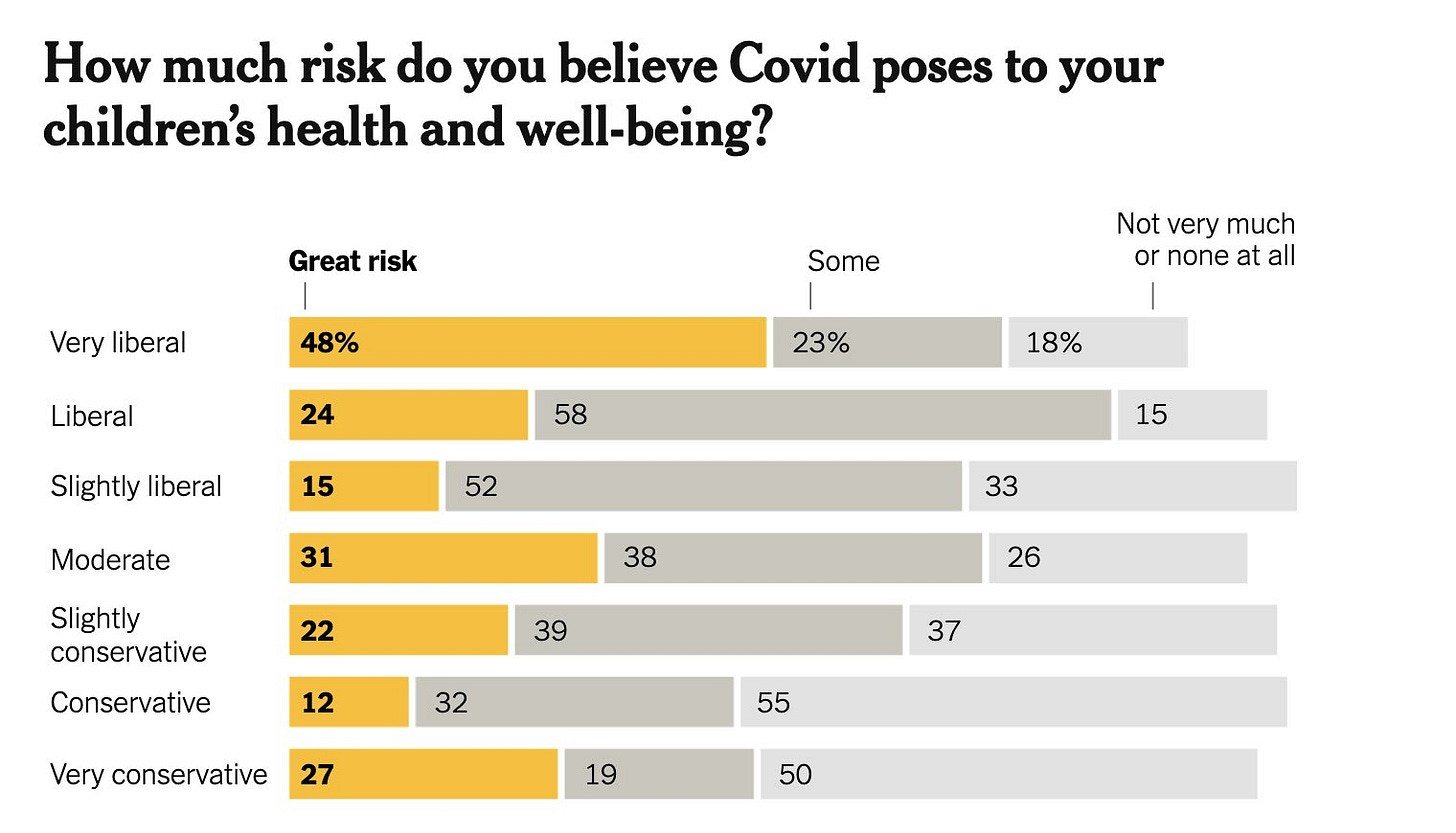
There is less than zero understanding that children are at less risk of Covid than adults, with five of seven groups being more worried about children, one being the same, and the only substantial drop being among the slightly liberal.
What’s most interesting here, to me, is that this is not the order one would expect. Slightly liberal people here are much less worried than ‘moderates’ or even the ‘very conservative.’ What’s up with that?
Especially considering this next one is much better ordered, although the wording of ‘will’ on the left and ‘should’ on the right is hopefully a typo cause it’s super weird?

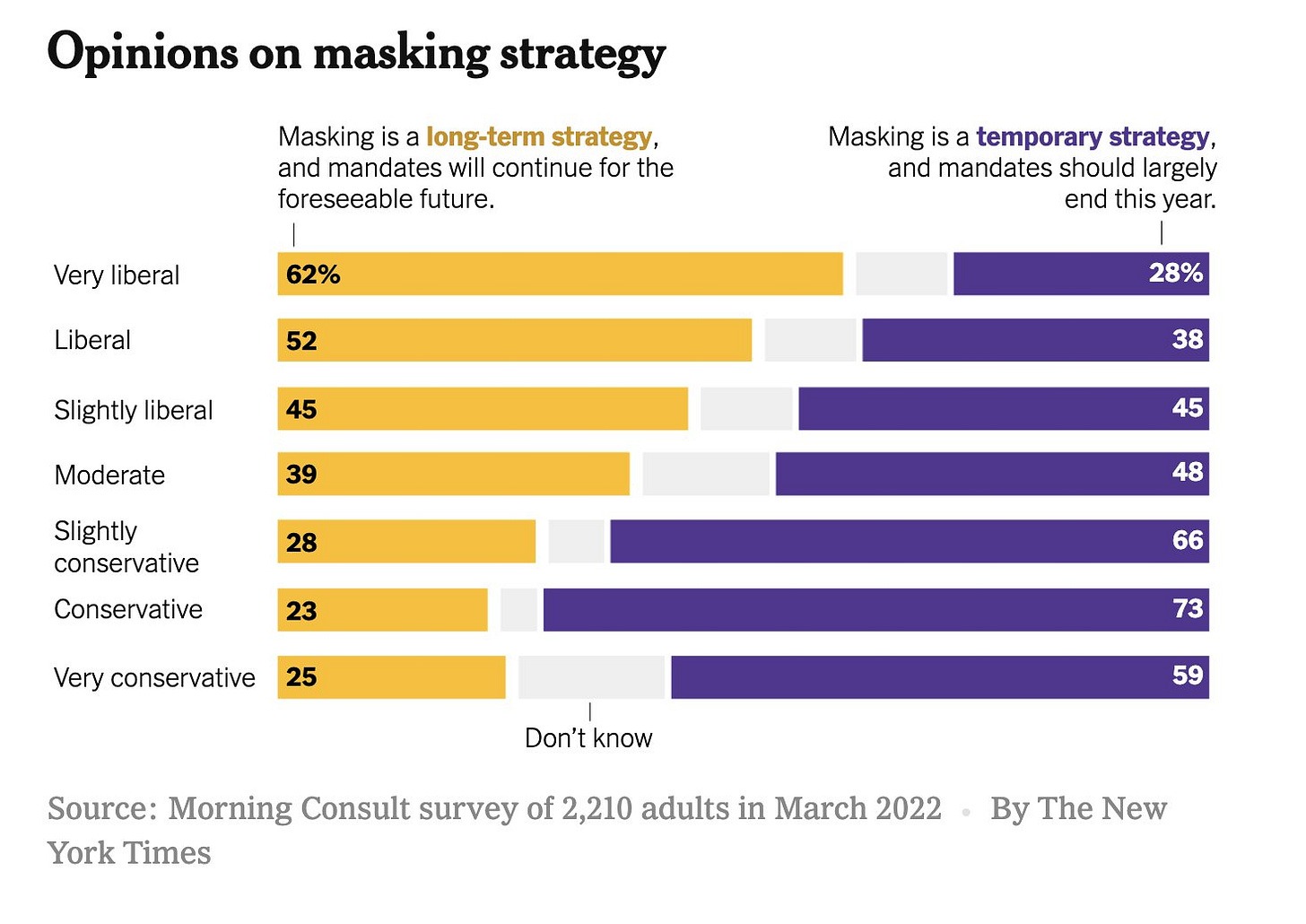
Very conservative people perhaps come by it somewhat more honestly, and are in fact ‘real’ conservatives, where a conservative person uses caution and worries about unknowns like new diseases, which could explain that bump. And for a similar theory, perhaps one could say that being ‘slightly liberal’ only happens for those capable of actually thinking in some sense, or else they’d be either more liberal (conforming to their group) or call themselves moderate. I’d like to buy that but it feels like a Just So Story, and the magnitude of this effect seems too big. Perhaps largely noise.
Meanwhile, many continue to be shut-ins, and 13 percent of people plan to make their changes permanent even if the pandemic fully goes away, while less than half plan a full return.
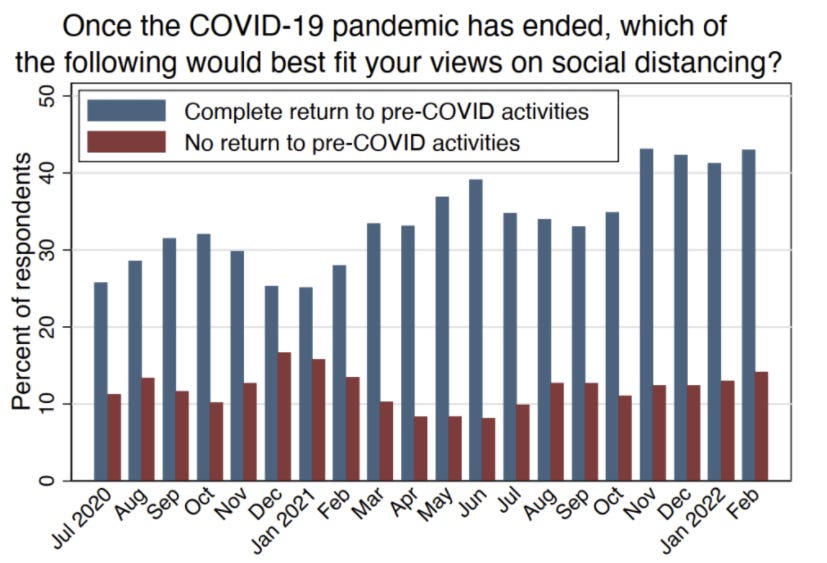
Long term, this alienation away from living life may inflict a far worse toll than anything else the pandemic did. We need to avoid this trap.
A good joke, and I get the point, but also seriously.


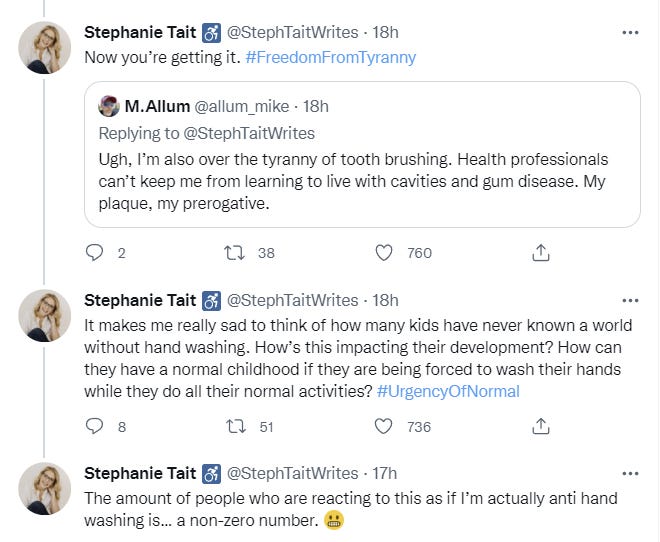
If you have not had the ‘pleasure’ of having a child who thinks words have meaning, who has had it drilled into him over and over how vital it is to wash his hands, and that then develops a rather unhealthy obsession with the need to wash them all the time in ways that are remarkably annoying and that damage his skin, then you are fortunate. If you did not have liquid glop forced upon you constantly in situations where it made no sense for two years, and having that be a stopper on activities as actively stressed people you care about scramble to find more glop, good for you. I was not so fortunate on either front, although situation has improved.
I certainly don’t want to be in a world where I lose points if I don’t wash my hands for no reason every time I do things like walk into a building. If you listened to the recommendations of ‘health professionals’ you would lose several minutes a day washing your hands, and often as a priority interrupt. Yes, you can afford any one such thing, but such things add up. One can always wash more often, or more carefully.
So yes, of course we should sometimes wash our hands, and doctors should wash theirs quite a lot, but we are talking price. And as with many other things, anyone who says they wash their hands less than the standard is going to get attacked for saying it and thus all such folks are inclined to shut up, and we should presume that talk about hand washing vastly overestimates actual handwashing rates.
As it turns out, what did hand washing do for us? A lot less than people thought, and the whole effort was almost certainly net negative because it outcompeted other prevention effects such as ventilation, being outdoors, masks and social distancing, all of which are vastly more impactful.
Biden administration releases new guidance on ventilation standards for schools and businesses. Ventilation is one of those things that is a good idea anyway, so a good place to look for worthwhile things to be doing. The guidance is two pages long, which seems like an ideal length, and it is recommendations rather than requirements. I do still worry about additional feature creep that renders it increasingly slow and expensive to operate in ordinary life, since this involves things like ‘hiring experts’ and such ‘recommendations’ send to turn into requirements (e.g. those praising this as a strong ‘first step’). As an only step, though, it seems good, and if we are going to impose requirements and be coercive this is a relatively good way.
We have to be willing to consider such clean examples.
Protesters at New York City restaurants that continue to require proof of vaccination, which they are entitled to do if they so choose. It is hard for me to get into the mindset where any of this is a good use of someone’s time – either the checking of vaccination cards, or the protesting that someone is checking them. If a place was continuing to check vaccine cards, I’d shrug and show them, but it would be a mark against me going back because I dislike annoying things.
Meanwhile, rates versus levels.

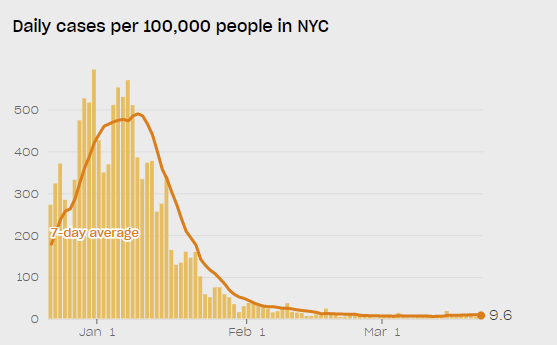
We need to ‘pick up the pace’ proportionally to cases. I walk by the kiosks on the sidewalk offering free Covid testing. There is almost no one ever there. Many providing the service no longer bother masking. Doing extra tests now, in advance of the cases, does not accomplish anything.
Think of the Children
New York City to lift the somehow still existing mask requirement for 2-4 year olds.
Source is biased but also this matches my personal experience quite a lot.

In Other News
I mean, yeah, sure, CDC Delenda Est and all that, and yes the fact that their documents still say that vaccine immunity is inferior to natural immunity is a “myth” is rather embarrassing and rather central, and yes the CDC has done tons of rather awful science in the pandemic, but I still don’t think that finding one blatant error in a document should be sufficient here. There are lots of documents. With lots of errors, mind, and overall terrible performance, but one does need to show the pattern.
Overview of the prospects for another Operation Warp Speed based on what we did and why it worked (MR). I am more optimistic than this on what results we would get given an actual attempt, even if not all the positive conditions are present.
The Precautionary Principle is not a dumb idea. A cost-benefit analysis that only includes the known risks is going to undervalue unknown risks, so if those unknown risks clearly favor one side or the other it is necessary to give some weight to that. The underlying post here is centrally an attack on Emily Oster for daring to consider things like cost-benefit or quality of evidence at all, using arguments like ‘some right-wing thinkers and some corporations like her arguments’ and ‘her arguments are used to justify policies I do not like’ and even ‘her audience is white.’ This Twitter take on the hit piece is somewhat less generous than that.
Nate Silver’s point here I think is mostly correct, at this point, if anything understated.

We don’t have ‘adequate substitutes’ for in-person interactions or being without masks. What we have are less inadequate substitutes, that let us muddle through. Emily’s recommendations on what pregnant women can safely do are similar. Either we are using the precautionary principle on all risks, or it is simply an excuse to do whatever ‘public health experts’ are worried about this week, forever.
At this point, there are large risks to sustaining interventions, and there are no studies to show that these risks are not worth worrying about and good reasons to expect the effect sizes might be very very large. So the ‘precautionary principle’ does not point in an obvious direction.
However, I do want to notice that yes, we have made a lot of pandemic arguments entirely about individual risk in many contexts where a lot of what matters is collective risk. We scream about the public health need to vaccinate, then argue that each individual person should make the choice purely selfishly, then when they don’t make the ‘right’ selfish decision we do various other things, and so on. Either make the real case, or don’t.
Press Secretary Psaki says “we don’t know” (26 second video) that Biden faces more danger from Covid than a person in their twenties. One could in theory steelman this reaction by saying that “we don’t know” that any particular old person will have a worse outcomes than any particular young person, and that would be the best kind of correct (aka technically correct), but given the spirit of the question, not so much.
Psaki now has Covid for the second time. I have the feeling she is properly not so worried about this, rather than saying ‘we don’t know.’
Kai Kupferschmidt has decided that the study of ‘misinformation’ is vital to work as a public health reporter, and has written an article about that. Extreme dangers are cited, evolutionary explanations are given, extreme solutions are proposed, such as:
Bak-Coleman, who has studied how schools of fish suppress false alarms from fish in the periphery of the swarm, believes the density of connections on social media make it harder to filter out bad information. Bergstrom agrees. “If we actually cared about resisting disinformation, Twitter and Facebook might be better off if they said, ‘Look, you can have 300 friends and that’s it,’” he says.
The solution to stopping the spread of misinformation is to stop having so many friends, or even more simply, stop conveying so much information.
The mistake, the ‘misinformation’ inherent in the situation, is the idea that there is a magisterium called ‘misinformation’ rather than one called ‘information.’ When we ask things like:
But that, too, needs study, he says, as do strategic questions: “What would agents do if they wanted to try to inject misinformation into a network? Where would they want to be? And then the flip side: How do you try to counter that?”
We are asking good questions, but what we are mostly asking is about the spread of information at all. Whether something happens to be true is certainly one input, but if you want a system to filter for true information that requires people build models and think. If you want it to filter for popular or official information, that is different, and then limiting what unpopular or unofficial people can say starts to look attractive. That kind of thinking seems unlikely to end well.
Thus, this kind of theory.
A recent review in Nature, however, argued that people do not fall for misinformation because of polarization. The authors cited studies suggesting true information is more likely to be believed than false information, even if it doesn’t align with one’s political views. “Politics does not trump truth,” they concluded. The real problem is people sharing information with little attention to whether it is true, the authors wrote.
So that comes back to the question of ‘what is misinformation?’ If misinformation is ‘information that is not true’ then the solution is to have more people do more model building and truth seeking. If misinformation is ‘information officials disagree with’ then you want the opposite of that, but you want to combine it with rebuilding official credibility in the eyes of the public. Which is useful in any case.
Solutions like ‘prevent people from communicating’ should be expected to reliably backfire barring extreme measures that would make us cease to be a free society. Russia can pull off this trick, but I hope we will not use that level of force.
I am deeply confused what point this article about Covid testing is trying to make, other than generally complaining that tests sucked so someone should get blamed for it? There are claims of non-standardization, of both undercounting and overcounting, and a general vibe of ‘sometimes the tests were wrong so everything is terrible.’ The main result of such things if any is likely more rules about tests that make tests less practically useful. The headline claim is of overcounts in the number of cases, as if that meant we were treating Covid as more of a problem than it was, or that it could possibly make up for the undercount of people not tested. What of course is being missed there is that an overcount would be bad news, since it would mean the death rate was higher.
Not Covid
Would this make the world better or worse? Poll respondents mostly say worse. I say better.

One formatting note: Some of the images in this post are wider than the main body of the post. In two cases, they’re overlapping the Archives and Blogroll sections on the right of the page. I’m seeing this in desktop Firefox on Windows 11.
Thank you for the note, I see it now.
Zvi, the inline pictures still render too wide to read. I have to go read this on lesswrong.
I think I fixed it now, but can someone who understands what happens explain why it happened now and didn’t happen earlier? I’ve been pasting from Substack like this for months now without the issue.
Looks good now, thanks!
Good. It’s not that hard to resize images, but if I have to do that for each image each time it’s going to add up fast. Hopefully this does not recur.
The poll asked about harm to the “health or well being” of the respondants or their kids. But anything that significantly harms their health or well being will almost certainly harm the kids’ well being too, and vice versa. So the two questions really are basically equivalent, except that the second one selects people who have kids.
The “very conservative” respondants are not worried about getting sick with Covid, they are worried about all the government intrusion and overreach harming their well being, especially because they suspect the government is out to get them specifically. The “moderates” are harder to explain, but I expect that they too are worried about harms from prevention measures rather than from the virus.
such ‘recommendations’ send to turn into requirements
Typo: send -> tend
Originally, changes in r0 were the most important thing to look at for new variants. Going forward, I expect that changes in immune escape will be much more important. Let S represent the susceptible individuals. r = r0 * S, so Δr = S * Δr0 + r0 * ΔS (to first order). Originally, almost everyone was susceptible, so S * Δr0 >> r0 * ΔS and it was important to focus on changes in r0. Now, almost noone is immunologically naive, so S is small. We expect that r0 * ΔS >> S * Δr0 and so we should care more about the change in susceptible fraction (i.e. how much immune escape there is compared to previous variants & vaccines) and about the base r0, and less about the change in r0. We can look at the data for omicron to see the extent to which this has been true, but going forward, this is what we should expect going forward.
“What’s most interesting here, to me, is that this is not the order one would expect. Slightly liberal people here are much less worried than ‘moderates’ or even the ‘very conservative.’ What’s up with that?”
I wonder how much covid has changed those categories. For example, take someone who considered themself conservative in 2019 and reliably supported the Republican Party’s position on most issues. If this person then decided that covid is a Big Problem, and supported the more interventionist position of the Democratic Party, they might consider themself to be moderate now. I don’t know if this is the main effect, and it doesn’t explain all the patterns, but it is a potentially important factor.
I feel like the antigenic seniority + overboosting discussion is fairly critical, and have yet to be convinced that 2 pfizer shots is too few for a normally healthy person <=40. Literally nobody I've talked to (including here), and I've tried reasonably hard elsewhere, has presented an evidence-based case for boosters in genpop that updates on information beyond November 2021 ('just do it, trust me' does not count), even without considering the antigenic seniority + booster question. If there is, I'd love to be pointed there…please??? Prove me wrong, anybody, it shouldn't be this hard.
3 shots is a lot more antibodies, a lot more protection against infection and against severe disease, as measured each time. You can run the math and decide you don’t care much because you value the marginal optionality for later, if you’d like – it’s a small mistake if you’re young and healthy. I’ve decided not to write The Long Vaccine Post at this point.
@Zvi, I just wanted to point out this is an example in action of the exact thing I was asking about last week that muddies the water in my opinion and doesn’t really answer the question Triskele is asking.
>3 shots is a lot more antibodies, a lot more protection against infection
This is still the short term answer right?. “Keep circulating anti-bodies high” is a Boost Forever strategy. It’s also a stop-the-spread strategy, which was fine at the time.
The real question Triskele is looking for ( I think) is more accurately: Once I am far enough out from initial shots that I no longer have high circulating anti-bodies because they naturally fade. What evidence we do we have that additional boosts are beneficial to me individually?
Not beneficial in the short term – we all know they are when circulating anti-bodies are high infection prevention is high – but in the long term once anti-body response has faded and it is up to your vaccinated immune system.
I think Triskele is correctly pointing out what I pointed out last week that this is a woefully under-discussed topic and it is very difficult to find information on, here or elsewhere.
The initial design of 2-fast-shots was clearly flawed in terms of long-term immunity – it is very rare for it to be good to do the 2nd shot that fast. Thus, a 3rd shot after several months should boost long term protection for individuals, even long term and without further shots. Obviously we don’t have hard evidence of that yet in the sense that it hasn’t happened, but the booster responses were well above the 2nd shot responses, and we have the prior.
I got the booster but do not intend to get additional boosters unless something changes.
Can someone explain this antigenic seniority issue? Zvi didn’t elaborate after quoting that thread. Is this some mechanism for a booster shot to somehow reduce one’s protection against disease? If so, it seems unlikely given the data we have on boosters so far?
It’s complicated but basically the danger is that by producing antibodies to one form of a thing, you might make the body fall back on similar antibodies in the future instead of creating antibodies that are a better fit for what you are actually up against – so a future infection/vaccination with Omega might not produce Omega-specific responses because of existing adaptations.
Re: misinformation and “fake news”, I think that people are forgetting that it existed long before the Internet existed – we just called them “rumors” or “gossip”. Rumors existed even inside the Soviet Union, so clearly they’re nearly impossible to get rid of. The Internet did make the “rumor cycle” faster than ever before, but I’m not sure if this is necessarily worse than the previous status quo. For an example, see this 1989 riot in India that started because of a rumor: https://en.wikipedia.org/wiki/1989_Bhagalpur_violence. Nowadays riots of this scale in India are a lot more rare despite most people having Internet access.
‘ … that their documents still say that vaccine immunity is superior to natural immunity is a “myth” … ‘ Did you mean ‘inferior’?
Yes.
“In an adversarial political system, such failures seem increasingly inevitable. One side spends all that it is given intending to come back for more, intentionally starving vital things of secured funds so that they can have a better case for more funding. The other side looks at that and says they’re not falling for such tactics, they’d rather not fund the vital things. And so it goes.”
I.e. the latter side correctly avoided Causal Decision Theory and the only real problem here is that the former side, rather than being dissuaded from repeating this strategy in the future, *enjoys* when vital things go unfunded because their voters will never, ever not draw the strategy arrow from Problems Get Worse to Give More Power To The People Loudest About The Problems.
FYI — A Johns Hopkins Econometrician has put up a pre-print of a paper that basically just puts all of the US monthly death data for the last 22 years in one place. https://www.researchgate.net/publication/359344397_US_Deaths_A_Look_at_Monthly_Data_1999-2021_FEB_2022_WORKING_PAPER_Genevieve_Briand
> ‘why is this cause different from all other causes?’
That is one of the four questions, and the answer is this: Paternalistic public policy reminds us of our slavery. We wear the mask to remind us that our freedom to speak is contingent upon the blessing of our betters, and hand washing reminds us that we must always keep ourselves protected from plausible accusations of blame within a two week time horizon.
I don’t understand your position on ‘we have no funding’. Surely it’s something more like ‘funding will henceforth come via the usual channels instead of the emergency ones’?
If my 75 year old relative goes to the hospital with covid, Medicare will cover Paxlovid, doctors/nurses/respiratory therapists, etc and so on. It will come from the normal Medicare budget rather than the ‘covid’ line item. If my 60 year old coworker goes to the hospital with covid, now insurance will cover paxlovid, doctors/nurses/respiratory therapists, etc and so on, rather than the ‘covid’ line item. If the poor family down the street…Medicaid.
Pfizer may not be able to sell vaccines directly to the federal government, but they ought now to be able to sell to the pharmacies, right?
The CDC can still collect statistics, as usual. The NIH can still issue grants. It’s just that now they have to displace something from their overall budget instead of having a separate special line item.
I guess it’s true that treating the uninsured is now a financial risk for the hospital and therefore might happen slightly less. But aside from that minor percentage of a small number, this seems like an accounting change rather than a physical reality change.
Direct patient treatment can largely still happen, but it won’t be the same seamless ‘it’s always free don’t worry about it’ it will be the mess that is our usual system. And other things will be trickier – e.g. if we don’t buy the Paxlovid other countries will buy it, and there are various other things that can’t be done through standard channels.
re: the tortured hand-washing metaphor, I wonder if Stephanie has an idea how many people are actually habitual hand-washers because I suspect (admittedly without going to look for data) this is a subject where the hand-washing adherents overestimate how many average folks that aren’t in professions where it’s a norm actually do in fact regularly wash their hands. Like, presumably there’s a reason that it’s a trope for public bathrooms to have a visible reminder that employees must wash their hands.
And as someone who’s kind of a compulsive hand-washer, when I think about this possibility (probability?) I can stop myself from having an instant panic attack over the hand-washing habits of Joe the Mechanic by reminding myself how incredibly unlikely it is to actually meaningfully maim me, which is a perspective sorely missing from that metaphor.
Dear Zvi:
1) How much protection do two shots of Pfizer, taken 9-12 months ago, give against the severe course and death caused by the BA2 variant?
2) Does it make sense to take a booster (third dose) now?
3) In case of infection, would you use the combination of Paxlovid, peginterferon, and fluvoxamine, or another one?
4) Should I give up hopes for the diagnostic mobile app?
5) What are your general expectations and speculations with regard to the 2022/2023 infectious season (variants, treatment options, lockdowns, death rates)?
6) Any recommendations with regard to the comfortable masks with a high degree of protection (N95 or higher) and no breathing resistance (wearable air purifiers), ensuring comfort during more strenuous activities? I’m thinking about LG PuriCare 2, but I’m curious if you know a better model. I can’t handle standard P100s, too much plastic smell and breathing resistance I’m sensitive to.
7) Any opinion about the protective nasal and mouth sprays with hyaluronan, ectoine, and iota-carrageen? They are marketed as an effective extra layer of protection against viruses (cold, flu, Covid-19).
8) How much should I worry about the negative health effects caused by the a) maintaining a highly sanitized lifestyle for over 2 years, implying the lack of contact with many pathogens, and b) a mental shift resulting in constant vigilance and a (post-)pandemic sense of social isolation?
Thank you in advance – your replies would be immensely helpful for me, my family, and many readers.
1) Same as BA1 (so safely 90%+).
2) I still think boosters are worthwhile but it makes LESS sense than it did a few months ago.
3) I’m not sold (or anti-sold) on peginterferon, but I’d to the other two.
4) Yes.
5) I expect not that many deaths and no major lockdowns barring a major new variant causing them. Treatment options should slowly improve. But cases won’t go away.
6) I haven’t looked into the super-masks myself, I wear N95s. Probably was a mistake but seems fine going forward now unless you’re super vulnerable.
7) No, except that I’m skeptical that they’re worth it for most people even if they work.
8) [A] not so much, it’ll pass, but [B] I worry about a lot.
Thank you, Zvi! I’m glad to hear that it’s still as much as >90%; I was afraid that the protection level decreases to 40-70% after a year. If you add Paxlovid+fluvoxamine+supplements to the equation, then Covid no longer seems like a concern.
Re: 8B, what aspects of that do you worry about the most?
Fabric of life and society becoming much weaker. People not having fun, not having friends, not connecting, not dating, not having kids, becoming agoraphobic or germaphobic. Thinking humans are to be avoided rather than embraced, and thinking that danger is around every corner. Most centrally, people forgetting what life is about.
It’s perfect recipe for an incel pandemic that is arguably far worse and far-reaching to society than COVID, for all the extremism they will cause.
Didn’t know vaccine passports are becoming optional in NYC.
(It is mandatory in HK for the foreseeable future)
Zvi, this might be a silly question, but how can I [male, 31, healthy, double-Pfizered one year ago] – based on the following data – guesstimate my probability of having Covid at the moment?
A few days ago I’ve started feeling more tired/nauseous/”viral” than usual, and in the last 24 hours, I’ve started experiencing a sore throat (no cough), mild shivers, plus an occasional mild discomfort in the nose. I’m quite confident I got less than 5000 microcovids in the last 10 days or so (<0.5% infection probability), none of the other 3 people in my flat (largely isolated from the world, <5000 total microcovids in the last 10 days or so) present any symptoms, my body temperature and SpO2 are normal. What should an aspiring Bayesian do with these data points? On one hand, Covid-19 seems unlikely; on the other one, the common cold virus is 5-10x less infectious, I didn't eat anything spicy/allergenic, and I'm not sure if talking a lot and/or stress can cause such symptoms.
I'm currently taking vitamin D3, C, fish oil, melatonin, black seed oil, quercetin, zinc, plus use Listerine and a throat spray with zinc gluconate, monitoring body temperature and SpO2. (When) should I consider getting tested, going to the doc (risking infection if I'm healthy), and looking for Paxlovid/fluvoxamine?
You can use a simple likelihood ratio, if you’re already estimating your microCovids, right? So how much more often do you get these kinds of symptoms when you’re positive versus negative, and multiply. But the simple thing to do is just get a rapid test (or PCR if it’s free/easy in your area) cause why not. The paranoia of ‘getting the test gets you infected’ seems way overblown here.
> However, I do want to notice that yes, we have made a lot of pandemic arguments entirely about individual risk in many contexts where a lot of what matters is collective risk. We scream about the public health need to vaccinate, then argue that each individual person should make the choice purely selfishly, then when they don’t make the ‘right’ selfish decision we do various other things […]
Whereas in dath ilan (counterfactually bungling the original response similarly), they scream about the public health need to vaccinate, then argue that each individual person should make the choice purely with the algorithm they usually make choices with, and perhaps add as a reminder that this situation is wholly analogous to voting in elections — clusters of relevantly similar agents predictably decide similarly.
Zvi, I’m observing an unusually high incidence of health issues in my circles (e.g. various infections and neuropathic/muscular pains, not even mentioning mental health conditions), affecting many young people in otherwise good shape. I suspect that the chronic stressors and a more sedentary, isolated lifestyle of recent years play a large role, but I wonder if the spike protein from infections or/and vaccines could be causing so many detrimental long-term effects (I assume the spike protein is toxic no matter how you get it, but vaccines are clearly net positive).
Could that be the case? If so, how could one measure and address this? It seems that the common markers of inflammation (ESR, CRP) might be insufficient.
The concern about the amount of ‘spike’ you get from the vaccine doesn’t make physical sense to me, but in terms of potential additional effects of Covid I did my best to look into the data in the Long Long Covid Post. If we have a suspicion in young healthy people in particular one could run a study comparing antibody status to symptoms of this nature. I agree with you that lifestyle changes in the last few years are a huge deal here, even if there’s also other things going on.
As for the other part of this, how to measure the thing that is wrong, yeah, we’d need to solve that first – there needs to be a clear marker. Would be good to be specific about exactly what things are going wrong so one could try and find a way to measure it.
What can we do (individually and at the systemic level) to – paraphrasing your earlier comment – restore the fabric of life and society, so people start having fun, friends, connections, dates, and kids? So they’re free from agoraphobia and germaphobia? So they think humans are to be embraced rather than avoided, and stop thinking about the danger hiding around every corner? So we remember what life is about?
Individually, hopefully you party like it’s 2019, except more so because you appreciate it more? Make an effort to see and make friends and all that other stuff? And be conscious about not worrying about germs and overcoming lethargy and fear. Be the change and all that.
Symbolically is harder to know, but it starts with individual action and in providing rhetorical and practical support for those around you to do the same.
My friend argues that if you’re a member of the low-status nerdy male caste, it is now nearly impossible to enjoy life. Conservatives exploit you, progressives find your very existence problematic (especially if you have an extra straight/white privilege), and for women, you are either an invisible being or the new favorite scapegoat. Career paths and institutions are full of landmines. Friendships and connections disappear when you’re not putting a disproportionate amount of effort into maintaining them. Dating/marriage/family is either impossible, too risky, or simply not worth it. Mental health boils down to pharmacological desensitization and psychotherapeutic gaslighting that may (or may not) make you feel less dead inside. Add the extra concerns of 2020-2022, and enjoy the dystopia.
I’m not sure if it’s reasonable to agree with this perspective, but it’s increasingly common, and I wasn’t really able to refute it – neither its specific parts, nor the general sentiment.
It’s a big red flag to me that enjoyment of life is tied so directly to the orientation of political factions (‘conservatives x, progressives do x, existence problematic,’, etc.). You don’t need the approval of the New York Times to be happy.
If politics depresses you then simply ignore it to whatever degree, which for many people still means completely. Put your newfound energy into literally anything which a.) requires effort and b.) you will get better at over time. Lifting would be an obvious example, but there are many others.
+1 to Gigachad’s comment, if you feel like existence in general (of either faction) is so problematic that it’s messing up your ability to enjoy life that’s something you need to find your way back from. It goes nowhere good.
Lifting is certainly a good default thing to do while you figure out other things to do.
I’m sure this will be a big thing in your next weekly, but any initial thoughts about fourth boosters for those now eligible? Especially wondering about my folks, who are in their mid-70s and generally healthy although one has significant asthma-style issues.
Lol oops you just posted, forget about it!